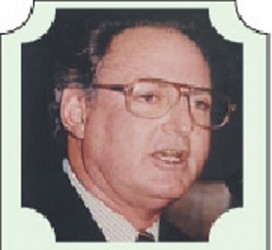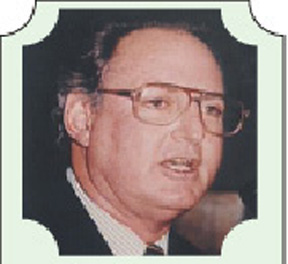By Tony Cozier

WHEN Shane Warne, the legendary Australian leg-spinner, and Marlon Samuels, the stylish if not so legendary West Indies batsman, angrily fronted to up to each other on the pitch at the Melbourne Cricket Ground in January 2013, Cricket Australia’s chief executive officer James Sutherland saw it as “something that only inspires a greater rivalry between two Melbourne teams and creates interest in the Big Bash League”.
It is presumably not a view publicly shared by other officials regarding the subsequent high profile, on-field clashes between players; they would rather deal with such matters promptly and move on. So it was when Barbados and West Indies fast bowler Tino Best and Pakistani batsman Shoaib Malik fronted up to each other after Best had knocked back Malik’s leg-stump in the Caribbean Premier League (CPL) match between Best’s St.Lucia Zouks and Malik’s Barbados Tridents at Kensington Oval on Wednesday night.
Television coverage beamed, according to CPL chief executive Damien O’Donohue, to over 200 million sets worldwide, showed Best’s feisty celebrations carrying through until he was within touching distance of Malik. Whatever was said, it prompted Malik to turn back and meet Best face-to-face. Against the regulations, he shoved him on his shoulder.
Umpires Gregory Brathwaite and Joel Wilson, two of the West Indies’ best, stepped in and later made a report to match referee, the Jamaican Denovan Hayles. Zouks’ captain Darren Sammy intervened to placate his rampant bowler.
That was not the end of it.
There was a further flare-up between Best and the Tridents’ captain Kieron Pollard on the teams’ return to the Hilton Hotel, their base for the Barbados leg of the tournament.
Credible eye-witnesses said that it was so heated they feared it would come to blows. Eventually, as the media reported, the two were separated by Sammy.
Again enhancing his standing as a strong leader, Sammy then escorted Pollard onto the beach and met with Best separately to cool them down.
It would not have been a straightforward task. As their records show, Best’s more clearly than Pollard’s, both are combustible characters in the heat of the contest.
The issue was further intensified by tweets from Malik’s wife, the Indian tennis player Sania Mirza, and Lendl Simmons, the Trinidad and Tobago batsman with the Guyana Amazon Warriors franchise.
Mirza raised the always contentious issue of race. Simmons simply taunted Best against whom he has had his battles in regional cricket over the years.
Mirza’s message read: “Racial abusing on a cricket field? Disgusting. I know (Shoaib) didn’t hit him but now I wish he would have.”
It was a serious charge at a time when all sporting bodies, among them the International Cricket Council (ICC), have introduced strict anti-racism regulations.
Here was an opportunity for the CPL, in its second year of operation, to publicly state in unequivocal terms that it would not stand for such behaviour in its tournament. It would have been a precise, positive message to players and public alike.
Instead, citing the West Indies Cricket Board (WICB) Code of Conduct, the governing code for the CPL, it announced simply the following day that both players had been fined for their on-field clash.
It also stated that it was investigating the “incident” at the team hotel but dismissed it as “minor and no one was hurt”.
Malik was docked 50 per cent of his match fee for breaching the code relating to “inappropriate and deliberate physical contact between players in the course of play”; Best lost 60 per cent of his match fee for two separate offences.
The second was far more serious and cost him 50 per cent. It charged Best with violating the clause in the code relating to “using language or a gesture(s) that is seriously obscene, seriously offensive or of a seriously insulting nature to another player.”
So was this what Malik’s wife meant by “racial abusing on a cricket field”?
It was a question the CPL left unanswered. It stated only that both players pleaded guilty to the charges against them so that the match referee was not required to hold any hearings into the incident.
Surely, it was its responsibility to undertake a thorough examination of what is a sordid issue with the potential to tarnish the reputation it has established in just two years.
O’Donohue asserted on the tournament’s website on Friday: “We take our responsibility to ensuring that we protect and promote the integrity of the tournament and the game itself very seriously.”
His comment was in relation to the arrest of three unnamed individuals for “suspicious behaviour at CPL games over the course of the tournament so far”.
Behaviour of the field of play is even more critical to ensuring the integrity of the tournament.
Not that the CPL is alone in its approach to controversy. When Mitchell Starc, the left-arm Australian swing bowler, and Pollard engaged in an ugly confrontation in an Indian Premier League (IPL) match in Mumbai last May they were penalized by match referee Andy Pycroft with match-fee fines – 75 per cent for Pollard, 50 per cent for Starc – and things moved on.
This was no ordinary spat. Starc, of the Royal Challengers Bangalore, had peppered Pollard with short-pitched bowling. “Words were exchanged”, to use the accepted jargon after Pollard had to hurriedly evade one bouncer. As Starc was on his approach for the next ball, Pollard pulled out of his stance. The Aussie responded by hurling the ball past him to the keeper, prompting a furious Pollard to throw his bat towards Starc.
They paid their fines and played on – as Best and Malik will do here.

